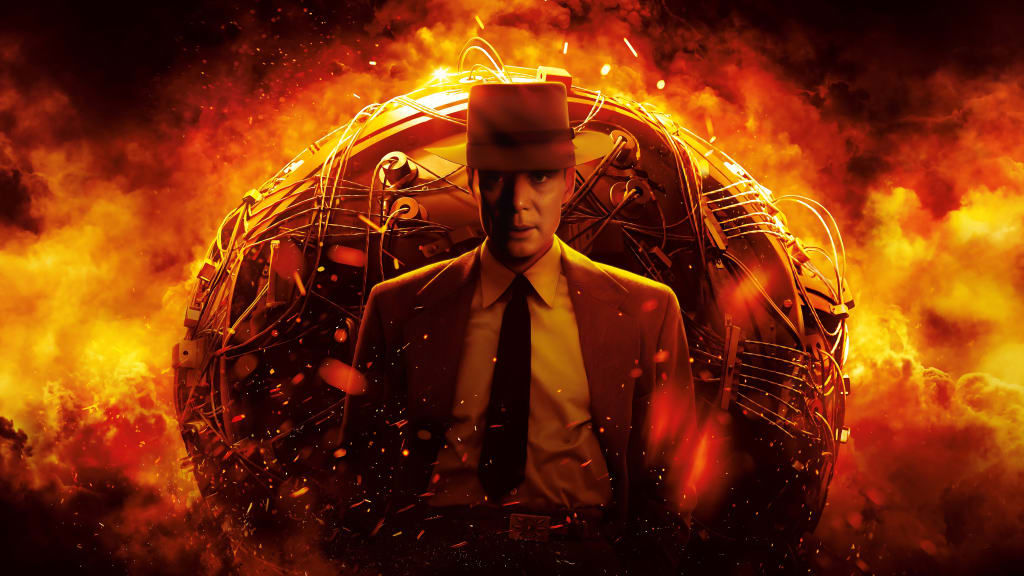Content warning
This story may contain sensitive material or discuss topics that some readers may find distressing. Reader discretion is advised. The views and opinions expressed in this story are those of the author and do not necessarily reflect the official policy or position of Vocal.

For all the pre-release speculation about how analogue epic-maker Christopher Nolan's "Oppenheimer" would re-create the explosion of the first atomic bomb, the film's most spectacular attraction turns out to be something else: the human face.
This three-plus hour biography of J. Robert Oppenheimer (Cillian Murphy) is a film about faces.
none more so than the title character, the supervisor of the nuclear weapons team at Los Alamos whose apocalyptic contribution to science earned him the nickname The American Prometheus (as per the title of Nolan's primary source, the biography by Kai Bird and Martin J. Sherman).
Nolan and cinematographer Hoyte van Hoytema use the large-format IMAX film system not merely to capture the splendor of New Mexico's desert panoramas but contrast the external coolness and internal turmoil of Oppenheimer, a brilliant mathematician, and low-key showman and leader whose impulsive nature and insatiable sexual appetites made his private life a disaster, and whose greatest contribution to civilization was a weapon that could destroy it.
Close-up after close-up shows star Cillian Murphy's face staring into the middle distance, off-screen, and sometimes directly into the lens, while Oppenheimer dissociates from unpleasant interactions, or gets lost inside memories, fantasies, and waking nightmares.
"Oppenheimer" rediscovers the power of huge closeups of people's faces as they grapple with who they are, and who other people have decided that they are, and what they've done to themselves and others.
Sometimes the close-ups of people's faces are interrupted by flash-cuts of events that haven't happened, or already happened.
There are recurring images of flame, debris, and smaller chain-reaction explosions that resemble strings of firecrackers, as well as non-incendiary images that evoke other awful, personal disasters.
But these don't just relate to the big bomb that Oppenheimer's team hopes to detonate in the desert, or the little ones that are constantly detonating in Oppenheimer's life, sometimes because he personally pushed the big red button in a moment of anger, pride or lust, and other times because he made a naive or thoughtless mistake that pissed somebody off long ago, and the wronged person retaliated with the equivalent of a time-delayed bomb.
The "fissile" cutting, to borrow a physics word, is also a metaphor for the domino effect caused by individual decisions, and the chain reaction that makes other things happen as a result.
This principle is also visualized by repeated images of ripples in water, starting with the opening closeup of raindrops setting off expanding circles on the surface that foreshadow both the ending of Oppenheimer's career as a government advisor and public figure and the explosion of the first nuke at Los Alamos (which observers see, then hear, then finally feel, in all its awful impact).
The weight of the film's interests and meanings are carried by faces—not just Oppenheimer's, but those of other significant characters, including General Leslie Groves (Matt Damon), Los Alamos' military supervisor; Robert's suffering wife Kitty Oppenheimer (Emily Blunt), whose tactical mind could have averted a lot of disasters if her husband would have only listened; and Lewis Strauss (Robert Downey, Jr.), the Atomic Energy Commission chair who despised Oppenheimer for a lot of reasons, including his decision to distance himself from his Jewish roots, and who spent several years trying to derail Oppenheimer's post-Los Alamos career.
Strauss is Salieri to Oppenheimer's Mozart, regularly and often pathetically reminding others that he studied physics, too, back in the day, and that he's a good person, unlike Oppenheimer the adulterer and communist sympathizer.
(This film asserts that Strauss leaked the FBI file on his progressive and communist associations to a third party who then wrote to the bureau's director, J. Edgar Hoover.)
The film speaks quite often of one of the principles of quantum physics, which holds that observing quantum phenomena by a detector or an instrument can change the results of this experiment.
The editing illustrates it by constantly re-framing our perception of an event to change its meaning, and the script does it by adding new information that undermines, contradicts, or expands our sense of why a character did something, or whether they even knew why they did it.
That, I believe, is really what "Oppenheimer" is about, much more so than the atom bomb itself, or even its impact on the war and the Japanese civilian population, which is talked about but never shown.
The film does show what the atom bomb does to human flesh, but it's not recreations of the actual attacks on Japan: the agonized Oppenheimer imagines Americans going through it.
But the film's furiously entropic tendencies complement the theoretical discussions of the how's and why's of the individual and collective personality.
About the Creator
KRISHNA JANA
I am passionate about content writing and believe in the power of words to make a positive impact on the world.
Enjoyed the story? Support the Creator.
Subscribe for free to receive all their stories in your feed. You could also pledge your support or give them a one-off tip, letting them know you appreciate their work.






Comments
There are no comments for this story
Be the first to respond and start the conversation.